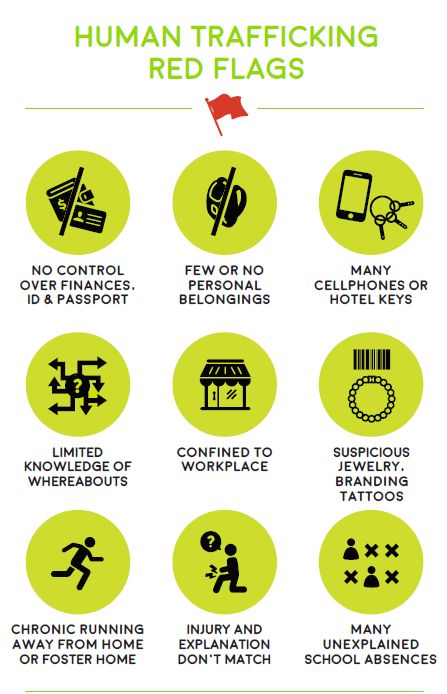
Think slavery and human trafficking are on the decline? Think again.
There is heartbreaking growth in trafficking statistics. Human trafficking is the fastest-growing crime on the planet; it’s second only to drug trafficking as the most profitable form of international crime.1
And while drugs are sold and then used once, human beings can be sold over and over again. The costs to the trafficker are low, and the profits are extremely high.2
This highlights the need for National Human Trafficking Prevention Month, which LifeWay marks each January with our Shed Light campaign.
What you need to know during National Human Trafficking Prevention Month
Human trafficking involves compelling or coercing a person to provide labor or services, or to engage in commercial sex acts.3 The coercion can be subtle or overt, physical or psychological. The exploitation of a minor for commercial sex is always trafficking, regardless of whether any force, fraud or coercion was used.4
While drugs are sold and then used once, human beings can be sold over and over again. The costs to the trafficker are low, and the profits are extremely high.
Human trafficking is fueled by a demand for cheap labor and for commercial sex.5 It happens in urban and rural settings. In all 50 states. It happens to men and to women of all races and religions and ethnic backgrounds in all kinds of settings.
Human trafficking is often confused with human smuggling, which involves crossing a border illegally. But human trafficking does not require any movement at all. Survivors can be recruited and trafficked in their own hometowns — even in their own homes.6
Trafficking victims are typically recruited by someone they know — such as a family member or caregiver (33%), an intimate partner (28%) or an employer (22%).7
Labor trafficking victims work in both legal and illegal labor industries, such as child care, elder care, the drug trade, massage parlors, nail and hair salons, restaurants, hotels, factories and farms. Sometimes victims are hidden away as domestic servants in a home. Others interact with people on a daily basis.8
Victims are exploited for commercial sex in a variety of settings, including on the street, in illicit massage parlors, cantinas, brothels or through escort services and online ads.9
Trafficking victims are typically recruited by someone they know — such as a family member or caregiver (33%), an intimate partner (28%) or an employer (22%).
The underlying conditions that make people vulnerable to sex and labor trafficking — poverty, environmental destruction, structural racism and discrimination, and general and economic equality — persist.10
Why you need to know about National Human Trafficking Prevention Month
Why is awareness so critical? Because it is very difficult for trafficking victims to come forward. They’re often physically and socially isolated in an unfamiliar culture, unable to speak or understand the language, without immigration papers, intimidated by their traffickers.11
People in sex trafficking situations may not see themselves as victims while being trafficked. They’ve been manipulated or groomed to believe they’re making their own choices. People in sex trafficking situations may depend on their traffickers for physical needs like money or housing. They also may face threats and violence against them or their families if they try to leave.12
But as a heinous crime and a human rights abuse, human trafficking broadly puts national and economic security at risk and harms the well-being of individuals and communities.
Our society risks normalizing sexual exploitation, ever-increasing child sexual abuse material production and consumption (made increasingly possible by technology), and growth in the victim-to-perpetrator cycle.13
People in sex trafficking situations may not see themselves as victims while being trafficked.
The toll of societal, generational and individual trauma is massive. This is why LifeWay Network confronts the reality of human trafficking every day by changing the future for women survivors through our safe housing program and increasing awareness and engagement through our education program.
More than 20 years ago, the Trafficking Victims Protection Act of 2000 codified the United States’ commitment to combating human trafficking. In 2010, President Obama proclaimed January “National Slavery and Human Trafficking Prevention Month”; every year since, each president has followed this tradition.14
It’s clear that abolishing human trafficking isn’t possible through one means or organization; instead, we need to build partnerships across all sectors of society — governmental, nonprofit, for-profit, educational and individual — to improve the lives of those we serve.

What you can do during National Human Trafficking Prevention Month
Recognize the signs
Red Flags
You might notice these things in someone you encounter in your daily life, or you may see signs in someone at a public event, in a hotel lobby or at a nearby worksite or restaurant.
- Does the person appear disconnected from family, friends, community organizations or houses of worship?
- Has a child stopped attending school?
- Has the person had a sudden or dramatic change in behavior?
- Is a juvenile engaged in commercial sex acts?
- Is the person disoriented or confused, or showing signs of mental or physical abuse?
- Does the person have bruises in various stages of healing?
- Is the person fearful, timid or submissive?
- Does the person show signs of having been denied food, water, sleep or medical care?
- Is the person often in the company of someone to whom he or she defers? Or someone who seems to be in control of the situation, e.g., where they go or who they talk to?
- Does the person appear to be coached on what to say?
- Is the person living in unsuitable conditions?
- Does the person lack personal possessions and appear not to have a stable living situation?
- Does the person have freedom of movement? Can the person freely leave where they live? Are there unreasonable security measures?
Questions to Ask
Assuming you have the opportunity to speak with a potential victim privately and without jeopardizing the victim’s safety because the trafficker is watching, here are some sample questions to ask to follow up on the red flags you became alert to:
- Can you leave your job if you want to?
- Can you come and go as you please?
- Have you been hurt or threatened if you tried to leave?
- Has your family been threatened?
- Do you live with your employer?
- Where do you sleep and eat?
- Are you in debt to your employer?
- Do you have your passport/identification? Who has it?
If you believe you have identified someone still in the trafficking situation, alert law enforcement immediately. It may be unsafe to attempt to rescue a trafficking victim.
911 Emergency
1-888-373-7888 National Human Trafficking Hotline
Learn about LifeWay’s work
LifeWay Network is the only organization in the metropolitan area that provides safe housing for both foreign- and domestic-born women ages 18 and over who were compelled into their trafficking situation for sex, labor or organ harvesting.
We provide short-term emergency housing, transitional housing and semi-independent housing.
Trafficking survivors require adequate recovery time.15 LifeWay Network utilizes a trauma-informed-care approach to address the survivor’s co-morbidity of needs.16
Our unique community living model comprises a 24/7 live-in host community of women religious and residential aides, a social worker and two qualified house managers. The cost to house a woman in our safe housing program for a month is roughly $6,000, including program overhead.
Women live in LifeWay’s safe housing for as long as 12 months, at which time the survivors’ goals are reviewed and next steps are determined.
During their stay, survivors participate in weekly community dinners and workshops, where they work on life skills, building community, expanding their financial literacy and healing. They also regularly take part in workshops for financial literacy to learn how to budget and save their money. They often attend classes, whether that be to attain their GED, a college degree, or a certification (i.e. culinary school or art classes).
LifeWay supports the transition to independence by working with survivors’ case managers to ensure they have wraparound services in place after they graduate from LifeWay Network. We stay connected to survivors, who also might serve as mentors to new residents.
Join the fight
You can do a world of good by partnering with LifeWay Network in the effort to shed light against human trafficking during National Human Trafficking Prevention Month and all year long.
- Schedule a presentation at your church, school, community gathering or workplace. We can customize a presentation for law enforcement, healthcare workers and other populations. Send an email to
- Become a monthly supporter of LifeWay Network. This helps fund the safe housing program, where survivors can live for as long as a year and take part in restorative practices such as crafts and yoga, or life skills training such as resume reviews and financial literacy.
- Give a one-time gift to LifeWay to be used for our most urgent needs.
- Volunteer with women survivors. Your skills are invaluable — share them with women eager to achieve freedom and self-sufficiency.
- Volunteer with our team. We’re always looking for virtual and in-person help planning fundraisers, making calls, implementing technology and other one-time and ongoing tasks.
- https://www.state.gov/united-states-advisory-council-on-human-trafficking-annual-report-2022/
- https://www.unicefusa.org/stories/what-fuels-human-trafficking
- https://www.dhs.gov/blue-campaign/what-human-trafficking
- https://www.justice.gov/humantrafficking/what-is-human-trafficking
- https://humantraffickinghotline.org/en/type-trafficking/human-trafficking
- https://humantraffickinghotline.org/en/human-trafficking/myths-facts
- https://polarisproject.org/wp-content/uploads/2020/07/Polaris-Analysis-of-2021-Data-from-the-National-Human-Trafficking-Hotline.pdf
- https://www.justice.gov/humantrafficking/what-is-human-trafficking
- https://www.justice.gov/humantrafficking/what-is-human-trafficking
- https://polarisproject.org/blog/2022/09/new-estimates-of-human-trafficking-in-the-world-shocking-but-not-surprising/
- https://www.acf.hhs.gov/archive/blog/2012/02/human-trafficking-why-awareness-matters
- https://polarisproject.org/understanding-human-trafficking/
- https://www.state.gov/united-states-advisory-council-on-human-trafficking-annual-report-2022/
- https://www.state.gov/national-human-trafficking-prevention-month/
- https://www.ncbi.nlm.nih.gov/pmc/articles/PMC2978168/
- https://nhttac.acf.hhs.gov/soar/soar-for-individuals/soar-online)
By Julianne Will
January 23, 2024
